Criminal Law & Procedure: A Report on UK Enforcement Agencies
VerifiedAdded on 2023/04/20
|12
|2734
|175
Report
AI Summary
This report provides an overview of criminal law and procedure in the UK, focusing on the roles and responsibilities of key enforcement agencies such as the police, the Crown Prosecution Service (CPS), and immigration enforcement. It details the structure and duties of the police, referencing the Police and Criminal Evidence Act 1984 (PACE) and its associated codes of practice. The report also examines the functions of the CPS in prosecuting criminal cases and the objectives of immigration enforcement in regulating migration. Additionally, the report highlights instances where enforcement agencies have faced criticism or failed to fully meet their obligations, emphasizing the need for continuous improvement and accountability within the criminal justice system. Desklib offers this report as a study resource, along with a vast library of solved assignments and study tools to support students.
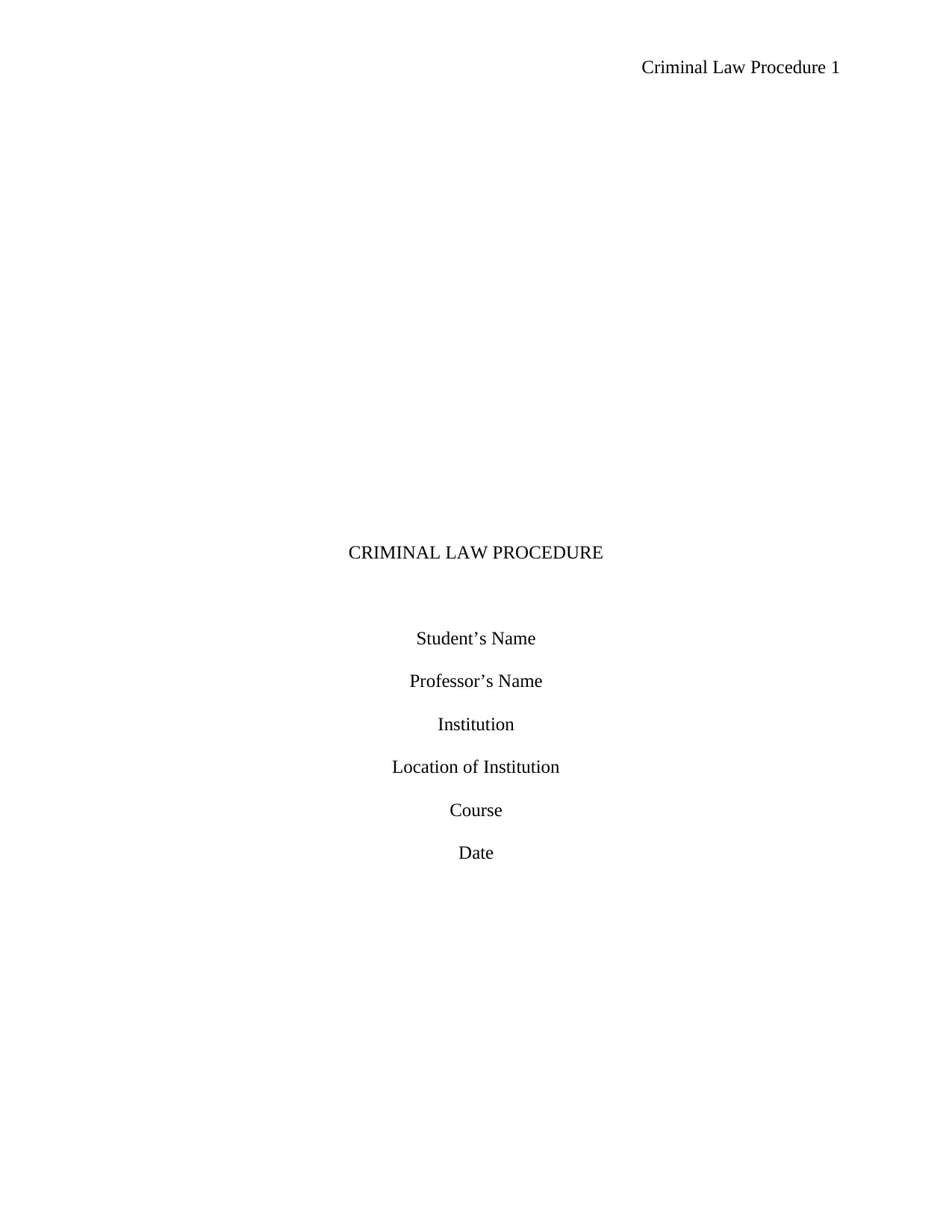
Criminal Law Procedure 1
CRIMINAL LAW PROCEDURE
Student’s Name
Professor’s Name
Institution
Location of Institution
Course
Date
CRIMINAL LAW PROCEDURE
Student’s Name
Professor’s Name
Institution
Location of Institution
Course
Date
Paraphrase This Document
Need a fresh take? Get an instant paraphrase of this document with our AI Paraphraser

Criminal Law Procedure 2
Table of Contents
Introduction......................................................................................................................................3
Procedure.........................................................................................................................................3
Findings...........................................................................................................................................4
Police in UK.................................................................................................................................4
Purpose and Structure of the Police.............................................................................................4
Territorial Structure......................................................................................................................4
Codes of Practice.........................................................................................................................5
Code A: Stop and Search..........................................................................................................5
Code G Powers of Arrest..........................................................................................................5
Cases Which Police Have Failed.................................................................................................5
O'Loughlin v Chief Constable of Essex [1998] I WLR 374........................................5
DCJ Osman \1 DPP (1999) The Times, 28 September.....................................................5
Duties of the Police......................................................................................................................6
Crown Prosecution Service..........................................................................................................6
Immigration Police.......................................................................................................................8
Immigration Team....................................................................................................................9
Vision.......................................................................................................................................9
Conclusion.....................................................................................................................................10
Recommendations..........................................................................................................................10
References List..............................................................................................................................11
Introduction
Table of Contents
Introduction......................................................................................................................................3
Procedure.........................................................................................................................................3
Findings...........................................................................................................................................4
Police in UK.................................................................................................................................4
Purpose and Structure of the Police.............................................................................................4
Territorial Structure......................................................................................................................4
Codes of Practice.........................................................................................................................5
Code A: Stop and Search..........................................................................................................5
Code G Powers of Arrest..........................................................................................................5
Cases Which Police Have Failed.................................................................................................5
O'Loughlin v Chief Constable of Essex [1998] I WLR 374........................................5
DCJ Osman \1 DPP (1999) The Times, 28 September.....................................................5
Duties of the Police......................................................................................................................6
Crown Prosecution Service..........................................................................................................6
Immigration Police.......................................................................................................................8
Immigration Team....................................................................................................................9
Vision.......................................................................................................................................9
Conclusion.....................................................................................................................................10
Recommendations..........................................................................................................................10
References List..............................................................................................................................11
Introduction
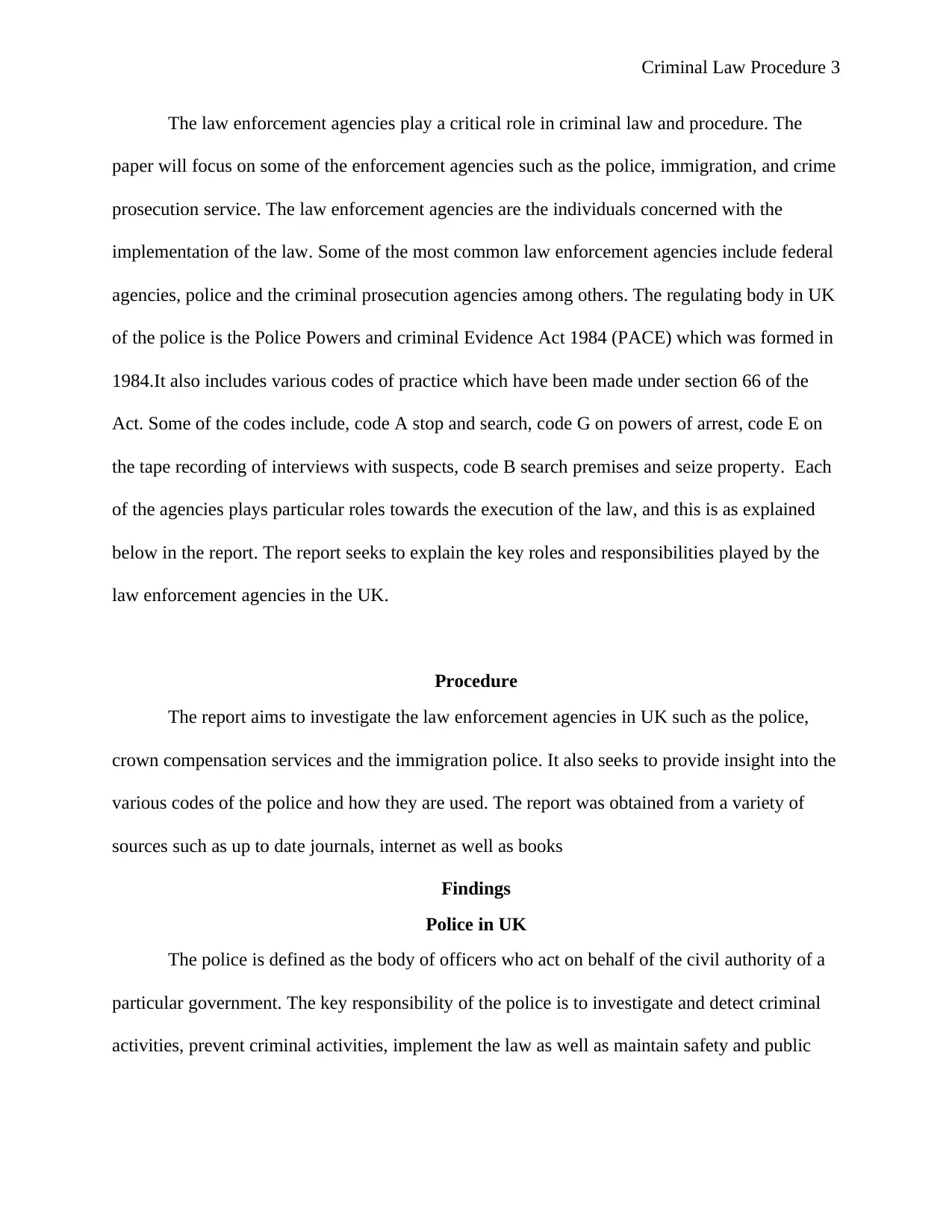
Criminal Law Procedure 3
The law enforcement agencies play a critical role in criminal law and procedure. The
paper will focus on some of the enforcement agencies such as the police, immigration, and crime
prosecution service. The law enforcement agencies are the individuals concerned with the
implementation of the law. Some of the most common law enforcement agencies include federal
agencies, police and the criminal prosecution agencies among others. The regulating body in UK
of the police is the Police Powers and criminal Evidence Act 1984 (PACE) which was formed in
1984.It also includes various codes of practice which have been made under section 66 of the
Act. Some of the codes include, code A stop and search, code G on powers of arrest, code E on
the tape recording of interviews with suspects, code B search premises and seize property. Each
of the agencies plays particular roles towards the execution of the law, and this is as explained
below in the report. The report seeks to explain the key roles and responsibilities played by the
law enforcement agencies in the UK.
Procedure
The report aims to investigate the law enforcement agencies in UK such as the police,
crown compensation services and the immigration police. It also seeks to provide insight into the
various codes of the police and how they are used. The report was obtained from a variety of
sources such as up to date journals, internet as well as books
Findings
Police in UK
The police is defined as the body of officers who act on behalf of the civil authority of a
particular government. The key responsibility of the police is to investigate and detect criminal
activities, prevent criminal activities, implement the law as well as maintain safety and public
The law enforcement agencies play a critical role in criminal law and procedure. The
paper will focus on some of the enforcement agencies such as the police, immigration, and crime
prosecution service. The law enforcement agencies are the individuals concerned with the
implementation of the law. Some of the most common law enforcement agencies include federal
agencies, police and the criminal prosecution agencies among others. The regulating body in UK
of the police is the Police Powers and criminal Evidence Act 1984 (PACE) which was formed in
1984.It also includes various codes of practice which have been made under section 66 of the
Act. Some of the codes include, code A stop and search, code G on powers of arrest, code E on
the tape recording of interviews with suspects, code B search premises and seize property. Each
of the agencies plays particular roles towards the execution of the law, and this is as explained
below in the report. The report seeks to explain the key roles and responsibilities played by the
law enforcement agencies in the UK.
Procedure
The report aims to investigate the law enforcement agencies in UK such as the police,
crown compensation services and the immigration police. It also seeks to provide insight into the
various codes of the police and how they are used. The report was obtained from a variety of
sources such as up to date journals, internet as well as books
Findings
Police in UK
The police is defined as the body of officers who act on behalf of the civil authority of a
particular government. The key responsibility of the police is to investigate and detect criminal
activities, prevent criminal activities, implement the law as well as maintain safety and public
⊘ This is a preview!⊘
Do you want full access?
Subscribe today to unlock all pages.

Trusted by 1+ million students worldwide
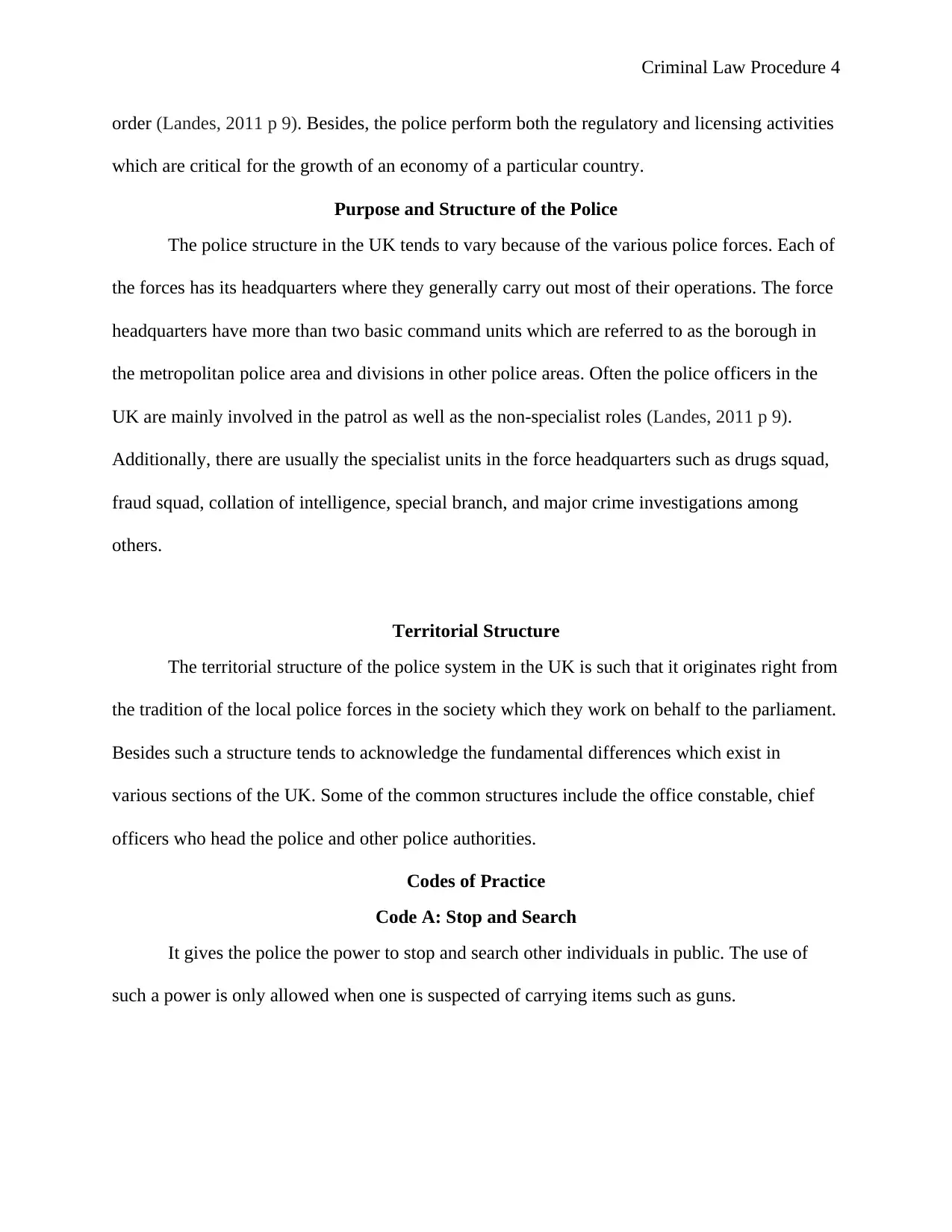
Criminal Law Procedure 4
order (Landes, 2011 p 9). Besides, the police perform both the regulatory and licensing activities
which are critical for the growth of an economy of a particular country.
Purpose and Structure of the Police
The police structure in the UK tends to vary because of the various police forces. Each of
the forces has its headquarters where they generally carry out most of their operations. The force
headquarters have more than two basic command units which are referred to as the borough in
the metropolitan police area and divisions in other police areas. Often the police officers in the
UK are mainly involved in the patrol as well as the non-specialist roles (Landes, 2011 p 9).
Additionally, there are usually the specialist units in the force headquarters such as drugs squad,
fraud squad, collation of intelligence, special branch, and major crime investigations among
others.
Territorial Structure
The territorial structure of the police system in the UK is such that it originates right from
the tradition of the local police forces in the society which they work on behalf to the parliament.
Besides such a structure tends to acknowledge the fundamental differences which exist in
various sections of the UK. Some of the common structures include the office constable, chief
officers who head the police and other police authorities.
Codes of Practice
Code A: Stop and Search
It gives the police the power to stop and search other individuals in public. The use of
such a power is only allowed when one is suspected of carrying items such as guns.
order (Landes, 2011 p 9). Besides, the police perform both the regulatory and licensing activities
which are critical for the growth of an economy of a particular country.
Purpose and Structure of the Police
The police structure in the UK tends to vary because of the various police forces. Each of
the forces has its headquarters where they generally carry out most of their operations. The force
headquarters have more than two basic command units which are referred to as the borough in
the metropolitan police area and divisions in other police areas. Often the police officers in the
UK are mainly involved in the patrol as well as the non-specialist roles (Landes, 2011 p 9).
Additionally, there are usually the specialist units in the force headquarters such as drugs squad,
fraud squad, collation of intelligence, special branch, and major crime investigations among
others.
Territorial Structure
The territorial structure of the police system in the UK is such that it originates right from
the tradition of the local police forces in the society which they work on behalf to the parliament.
Besides such a structure tends to acknowledge the fundamental differences which exist in
various sections of the UK. Some of the common structures include the office constable, chief
officers who head the police and other police authorities.
Codes of Practice
Code A: Stop and Search
It gives the police the power to stop and search other individuals in public. The use of
such a power is only allowed when one is suspected of carrying items such as guns.
Paraphrase This Document
Need a fresh take? Get an instant paraphrase of this document with our AI Paraphraser
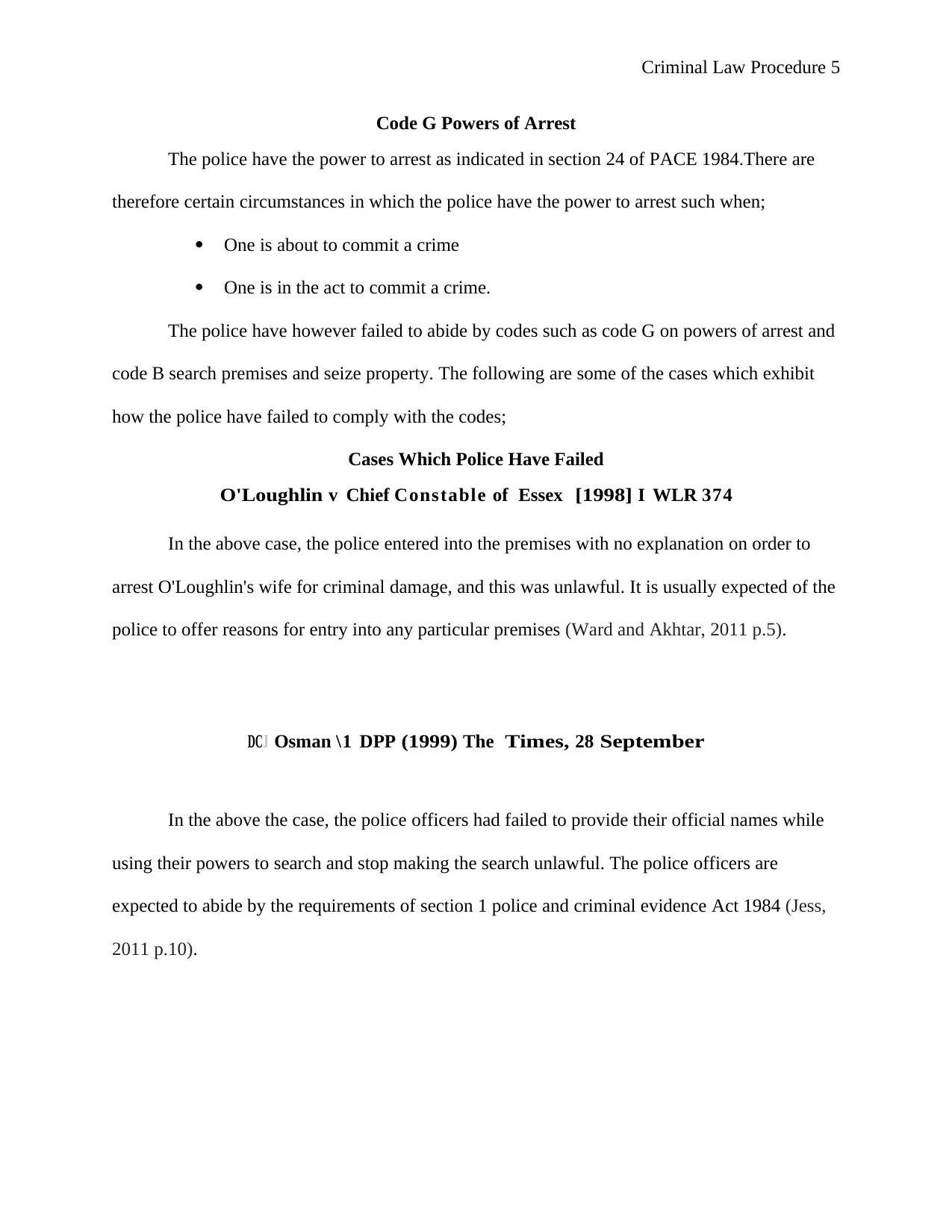
Criminal Law Procedure 5
Code G Powers of Arrest
The police have the power to arrest as indicated in section 24 of PACE 1984.There are
therefore certain circumstances in which the police have the power to arrest such when;
One is about to commit a crime
One is in the act to commit a crime.
The police have however failed to abide by codes such as code G on powers of arrest and
code B search premises and seize property. The following are some of the cases which exhibit
how the police have failed to comply with the codes;
Cases Which Police Have Failed
O'Loughlin v Chief Constable of Essex [1998] I WLR 374
In the above case, the police entered into the premises with no explanation on order to
arrest O'Loughlin's wife for criminal damage, and this was unlawful. It is usually expected of the
police to offer reasons for entry into any particular premises (Ward and Akhtar, 2011 p.5).
DCJ Osman \1 DPP (1999) The Times, 28 September
In the above the case, the police officers had failed to provide their official names while
using their powers to search and stop making the search unlawful. The police officers are
expected to abide by the requirements of section 1 police and criminal evidence Act 1984 (Jess,
2011 p.10).
Code G Powers of Arrest
The police have the power to arrest as indicated in section 24 of PACE 1984.There are
therefore certain circumstances in which the police have the power to arrest such when;
One is about to commit a crime
One is in the act to commit a crime.
The police have however failed to abide by codes such as code G on powers of arrest and
code B search premises and seize property. The following are some of the cases which exhibit
how the police have failed to comply with the codes;
Cases Which Police Have Failed
O'Loughlin v Chief Constable of Essex [1998] I WLR 374
In the above case, the police entered into the premises with no explanation on order to
arrest O'Loughlin's wife for criminal damage, and this was unlawful. It is usually expected of the
police to offer reasons for entry into any particular premises (Ward and Akhtar, 2011 p.5).
DCJ Osman \1 DPP (1999) The Times, 28 September
In the above the case, the police officers had failed to provide their official names while
using their powers to search and stop making the search unlawful. The police officers are
expected to abide by the requirements of section 1 police and criminal evidence Act 1984 (Jess,
2011 p.10).
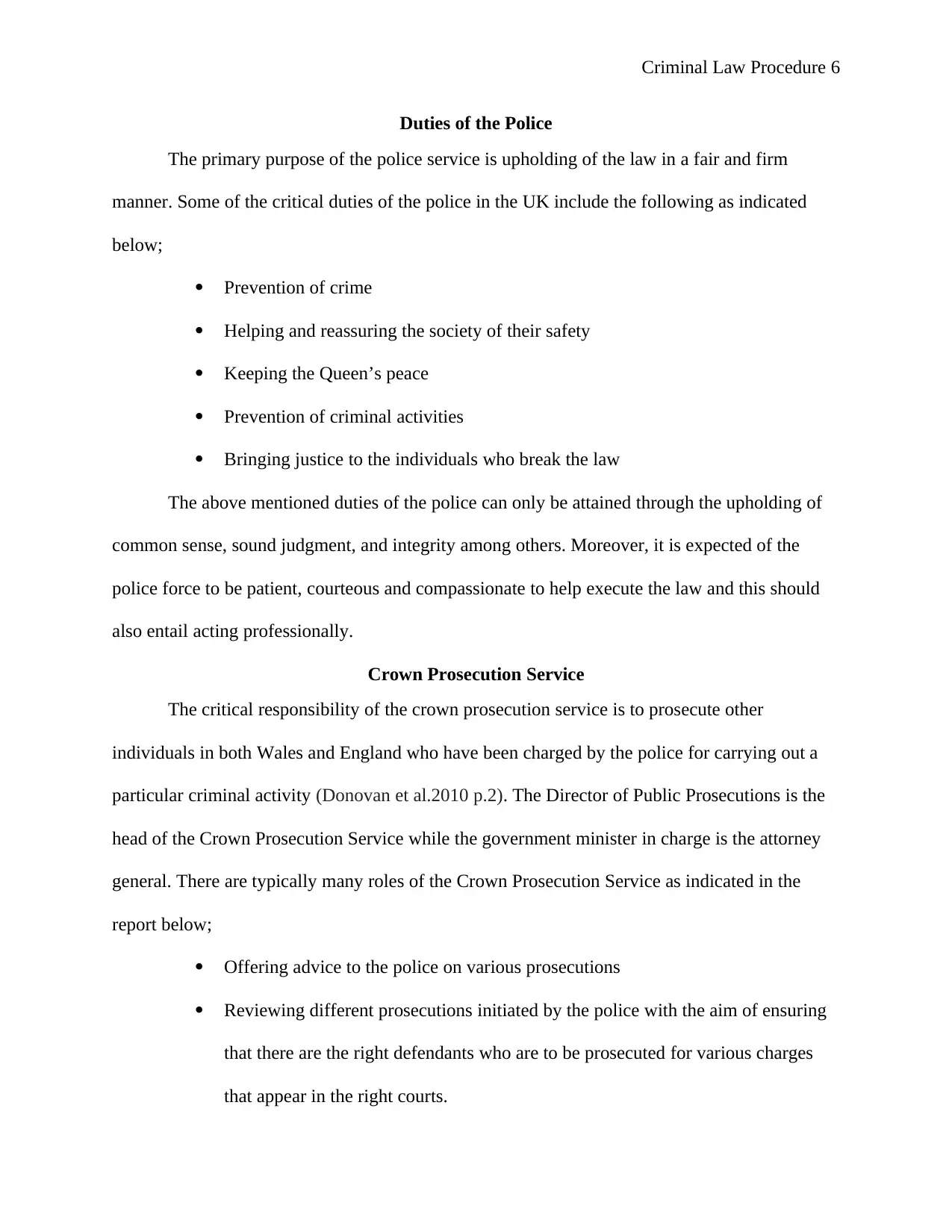
Criminal Law Procedure 6
Duties of the Police
The primary purpose of the police service is upholding of the law in a fair and firm
manner. Some of the critical duties of the police in the UK include the following as indicated
below;
Prevention of crime
Helping and reassuring the society of their safety
Keeping the Queen’s peace
Prevention of criminal activities
Bringing justice to the individuals who break the law
The above mentioned duties of the police can only be attained through the upholding of
common sense, sound judgment, and integrity among others. Moreover, it is expected of the
police force to be patient, courteous and compassionate to help execute the law and this should
also entail acting professionally.
Crown Prosecution Service
The critical responsibility of the crown prosecution service is to prosecute other
individuals in both Wales and England who have been charged by the police for carrying out a
particular criminal activity (Donovan et al.2010 p.2). The Director of Public Prosecutions is the
head of the Crown Prosecution Service while the government minister in charge is the attorney
general. There are typically many roles of the Crown Prosecution Service as indicated in the
report below;
Offering advice to the police on various prosecutions
Reviewing different prosecutions initiated by the police with the aim of ensuring
that there are the right defendants who are to be prosecuted for various charges
that appear in the right courts.
Duties of the Police
The primary purpose of the police service is upholding of the law in a fair and firm
manner. Some of the critical duties of the police in the UK include the following as indicated
below;
Prevention of crime
Helping and reassuring the society of their safety
Keeping the Queen’s peace
Prevention of criminal activities
Bringing justice to the individuals who break the law
The above mentioned duties of the police can only be attained through the upholding of
common sense, sound judgment, and integrity among others. Moreover, it is expected of the
police force to be patient, courteous and compassionate to help execute the law and this should
also entail acting professionally.
Crown Prosecution Service
The critical responsibility of the crown prosecution service is to prosecute other
individuals in both Wales and England who have been charged by the police for carrying out a
particular criminal activity (Donovan et al.2010 p.2). The Director of Public Prosecutions is the
head of the Crown Prosecution Service while the government minister in charge is the attorney
general. There are typically many roles of the Crown Prosecution Service as indicated in the
report below;
Offering advice to the police on various prosecutions
Reviewing different prosecutions initiated by the police with the aim of ensuring
that there are the right defendants who are to be prosecuted for various charges
that appear in the right courts.
⊘ This is a preview!⊘
Do you want full access?
Subscribe today to unlock all pages.

Trusted by 1+ million students worldwide
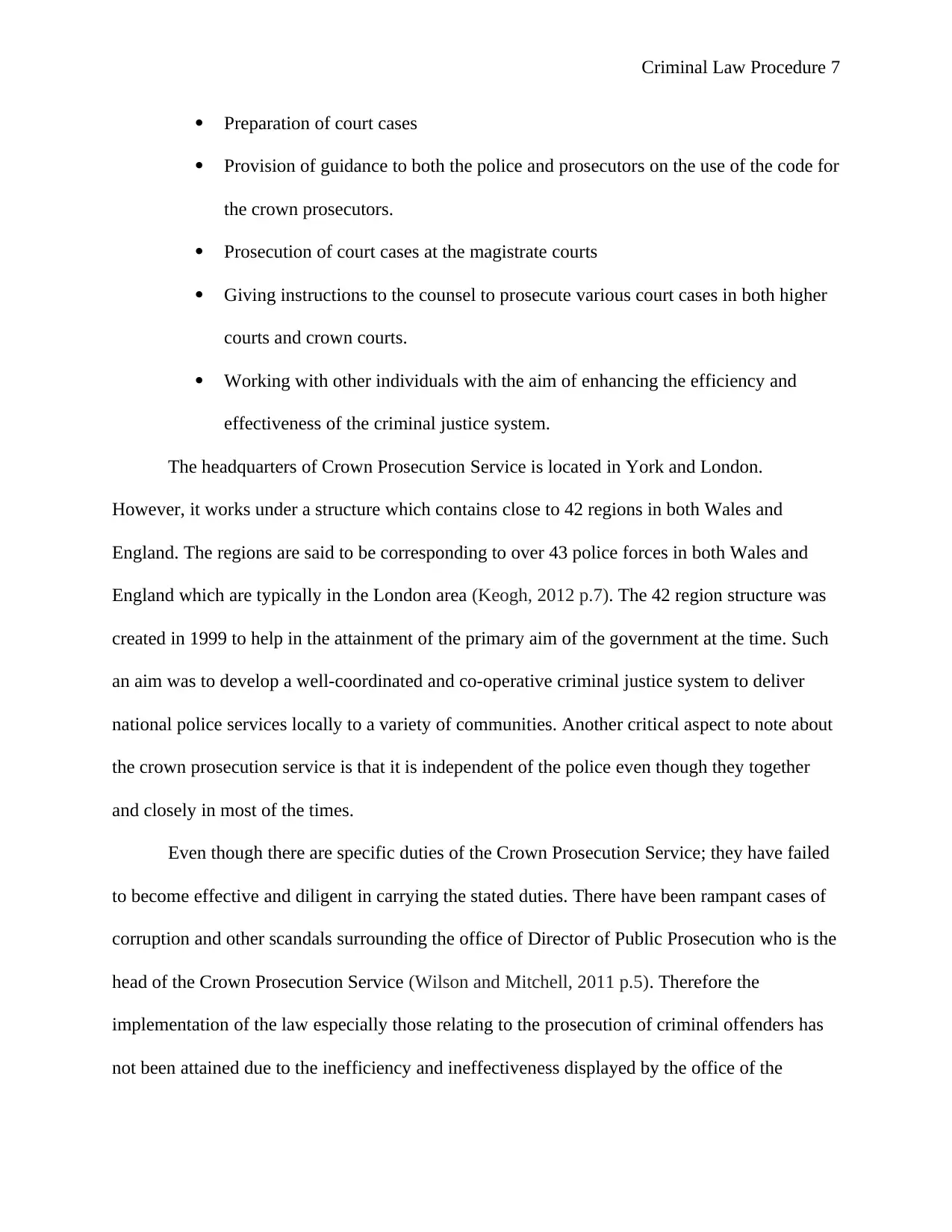
Criminal Law Procedure 7
Preparation of court cases
Provision of guidance to both the police and prosecutors on the use of the code for
the crown prosecutors.
Prosecution of court cases at the magistrate courts
Giving instructions to the counsel to prosecute various court cases in both higher
courts and crown courts.
Working with other individuals with the aim of enhancing the efficiency and
effectiveness of the criminal justice system.
The headquarters of Crown Prosecution Service is located in York and London.
However, it works under a structure which contains close to 42 regions in both Wales and
England. The regions are said to be corresponding to over 43 police forces in both Wales and
England which are typically in the London area (Keogh, 2012 p.7). The 42 region structure was
created in 1999 to help in the attainment of the primary aim of the government at the time. Such
an aim was to develop a well-coordinated and co-operative criminal justice system to deliver
national police services locally to a variety of communities. Another critical aspect to note about
the crown prosecution service is that it is independent of the police even though they together
and closely in most of the times.
Even though there are specific duties of the Crown Prosecution Service; they have failed
to become effective and diligent in carrying the stated duties. There have been rampant cases of
corruption and other scandals surrounding the office of Director of Public Prosecution who is the
head of the Crown Prosecution Service (Wilson and Mitchell, 2011 p.5). Therefore the
implementation of the law especially those relating to the prosecution of criminal offenders has
not been attained due to the inefficiency and ineffectiveness displayed by the office of the
Preparation of court cases
Provision of guidance to both the police and prosecutors on the use of the code for
the crown prosecutors.
Prosecution of court cases at the magistrate courts
Giving instructions to the counsel to prosecute various court cases in both higher
courts and crown courts.
Working with other individuals with the aim of enhancing the efficiency and
effectiveness of the criminal justice system.
The headquarters of Crown Prosecution Service is located in York and London.
However, it works under a structure which contains close to 42 regions in both Wales and
England. The regions are said to be corresponding to over 43 police forces in both Wales and
England which are typically in the London area (Keogh, 2012 p.7). The 42 region structure was
created in 1999 to help in the attainment of the primary aim of the government at the time. Such
an aim was to develop a well-coordinated and co-operative criminal justice system to deliver
national police services locally to a variety of communities. Another critical aspect to note about
the crown prosecution service is that it is independent of the police even though they together
and closely in most of the times.
Even though there are specific duties of the Crown Prosecution Service; they have failed
to become effective and diligent in carrying the stated duties. There have been rampant cases of
corruption and other scandals surrounding the office of Director of Public Prosecution who is the
head of the Crown Prosecution Service (Wilson and Mitchell, 2011 p.5). Therefore the
implementation of the law especially those relating to the prosecution of criminal offenders has
not been attained due to the inefficiency and ineffectiveness displayed by the office of the
Paraphrase This Document
Need a fresh take? Get an instant paraphrase of this document with our AI Paraphraser

Criminal Law Procedure 8
Director of Public Prosecution. Consequently, the criminal offenders have been left to free and
continuing with their terrorization activities of the community. In a few years back, a special
committee was formed to help in the implementation of the law by the crown prosecution
services.
Immigration Police
Immigration enforcement was established in 2012. The major role was to track
immigration offenders, increase compliance with the immigration law as well as to prevent
abuse. It is one of the law enforcement agencies in the UK where it has partnered with a variety
of other law enforcement agencies which include the police to help in the regulation of the
migration line with the policies of the government (Ashworth and Horder, 2013 p.40). Besides, it
supports economic growth by ensuring that the laws regarding trading activities primarily for the
foreign investors are complied by all.
The immigration and nationality directorate is the arm of the Home Office concerned
with the regions of nationality and immigration (ROHLFING, 2017 p.100). Additionally, it
grants leave to remain, deportation, breaches of staff of stay, policing frontier controls and the
staffing ports. Usually, the officers in the immigration department are involved in the conduction
of various investigations including interviews aimed at pursuing illegal immigrants. Such
immigrants tend to provide false information on applications for visas, citizenship as well as
asylum. They are also involved in the law enforcement which they conduct through the
coordination of a variety of activities with other agencies such as the police and crown
prosecution services agencies.
Immigration Team
According to Brayne, Carr, and Goosey (2015 p.5), the immigration enforcement team is
made of staff members who carry out specific duties in both overseas and the UK, and this
Director of Public Prosecution. Consequently, the criminal offenders have been left to free and
continuing with their terrorization activities of the community. In a few years back, a special
committee was formed to help in the implementation of the law by the crown prosecution
services.
Immigration Police
Immigration enforcement was established in 2012. The major role was to track
immigration offenders, increase compliance with the immigration law as well as to prevent
abuse. It is one of the law enforcement agencies in the UK where it has partnered with a variety
of other law enforcement agencies which include the police to help in the regulation of the
migration line with the policies of the government (Ashworth and Horder, 2013 p.40). Besides, it
supports economic growth by ensuring that the laws regarding trading activities primarily for the
foreign investors are complied by all.
The immigration and nationality directorate is the arm of the Home Office concerned
with the regions of nationality and immigration (ROHLFING, 2017 p.100). Additionally, it
grants leave to remain, deportation, breaches of staff of stay, policing frontier controls and the
staffing ports. Usually, the officers in the immigration department are involved in the conduction
of various investigations including interviews aimed at pursuing illegal immigrants. Such
immigrants tend to provide false information on applications for visas, citizenship as well as
asylum. They are also involved in the law enforcement which they conduct through the
coordination of a variety of activities with other agencies such as the police and crown
prosecution services agencies.
Immigration Team
According to Brayne, Carr, and Goosey (2015 p.5), the immigration enforcement team is
made of staff members who carry out specific duties in both overseas and the UK, and this
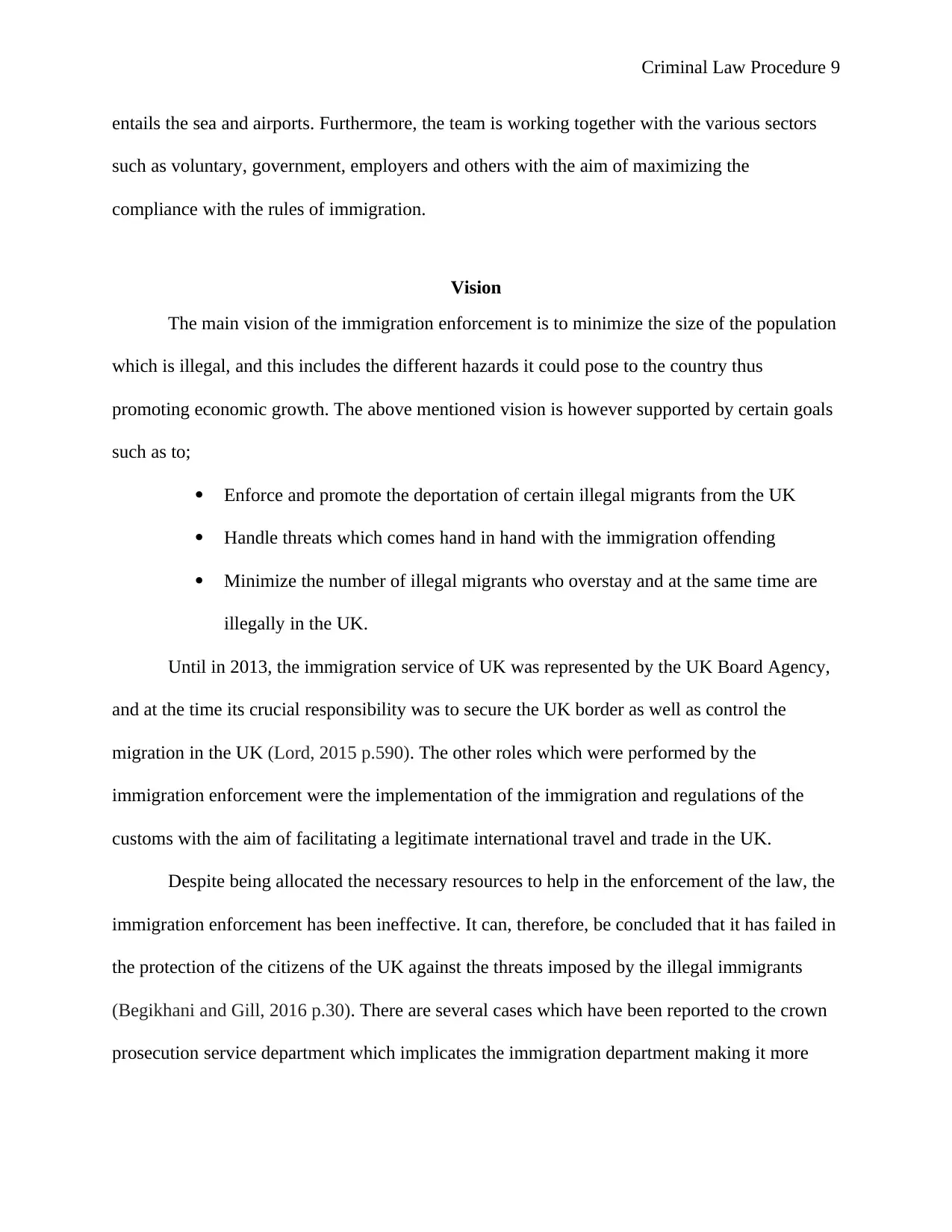
Criminal Law Procedure 9
entails the sea and airports. Furthermore, the team is working together with the various sectors
such as voluntary, government, employers and others with the aim of maximizing the
compliance with the rules of immigration.
Vision
The main vision of the immigration enforcement is to minimize the size of the population
which is illegal, and this includes the different hazards it could pose to the country thus
promoting economic growth. The above mentioned vision is however supported by certain goals
such as to;
Enforce and promote the deportation of certain illegal migrants from the UK
Handle threats which comes hand in hand with the immigration offending
Minimize the number of illegal migrants who overstay and at the same time are
illegally in the UK.
Until in 2013, the immigration service of UK was represented by the UK Board Agency,
and at the time its crucial responsibility was to secure the UK border as well as control the
migration in the UK (Lord, 2015 p.590). The other roles which were performed by the
immigration enforcement were the implementation of the immigration and regulations of the
customs with the aim of facilitating a legitimate international travel and trade in the UK.
Despite being allocated the necessary resources to help in the enforcement of the law, the
immigration enforcement has been ineffective. It can, therefore, be concluded that it has failed in
the protection of the citizens of the UK against the threats imposed by the illegal immigrants
(Begikhani and Gill, 2016 p.30). There are several cases which have been reported to the crown
prosecution service department which implicates the immigration department making it more
entails the sea and airports. Furthermore, the team is working together with the various sectors
such as voluntary, government, employers and others with the aim of maximizing the
compliance with the rules of immigration.
Vision
The main vision of the immigration enforcement is to minimize the size of the population
which is illegal, and this includes the different hazards it could pose to the country thus
promoting economic growth. The above mentioned vision is however supported by certain goals
such as to;
Enforce and promote the deportation of certain illegal migrants from the UK
Handle threats which comes hand in hand with the immigration offending
Minimize the number of illegal migrants who overstay and at the same time are
illegally in the UK.
Until in 2013, the immigration service of UK was represented by the UK Board Agency,
and at the time its crucial responsibility was to secure the UK border as well as control the
migration in the UK (Lord, 2015 p.590). The other roles which were performed by the
immigration enforcement were the implementation of the immigration and regulations of the
customs with the aim of facilitating a legitimate international travel and trade in the UK.
Despite being allocated the necessary resources to help in the enforcement of the law, the
immigration enforcement has been ineffective. It can, therefore, be concluded that it has failed in
the protection of the citizens of the UK against the threats imposed by the illegal immigrants
(Begikhani and Gill, 2016 p.30). There are several cases which have been reported to the crown
prosecution service department which implicates the immigration department making it more
⊘ This is a preview!⊘
Do you want full access?
Subscribe today to unlock all pages.

Trusted by 1+ million students worldwide
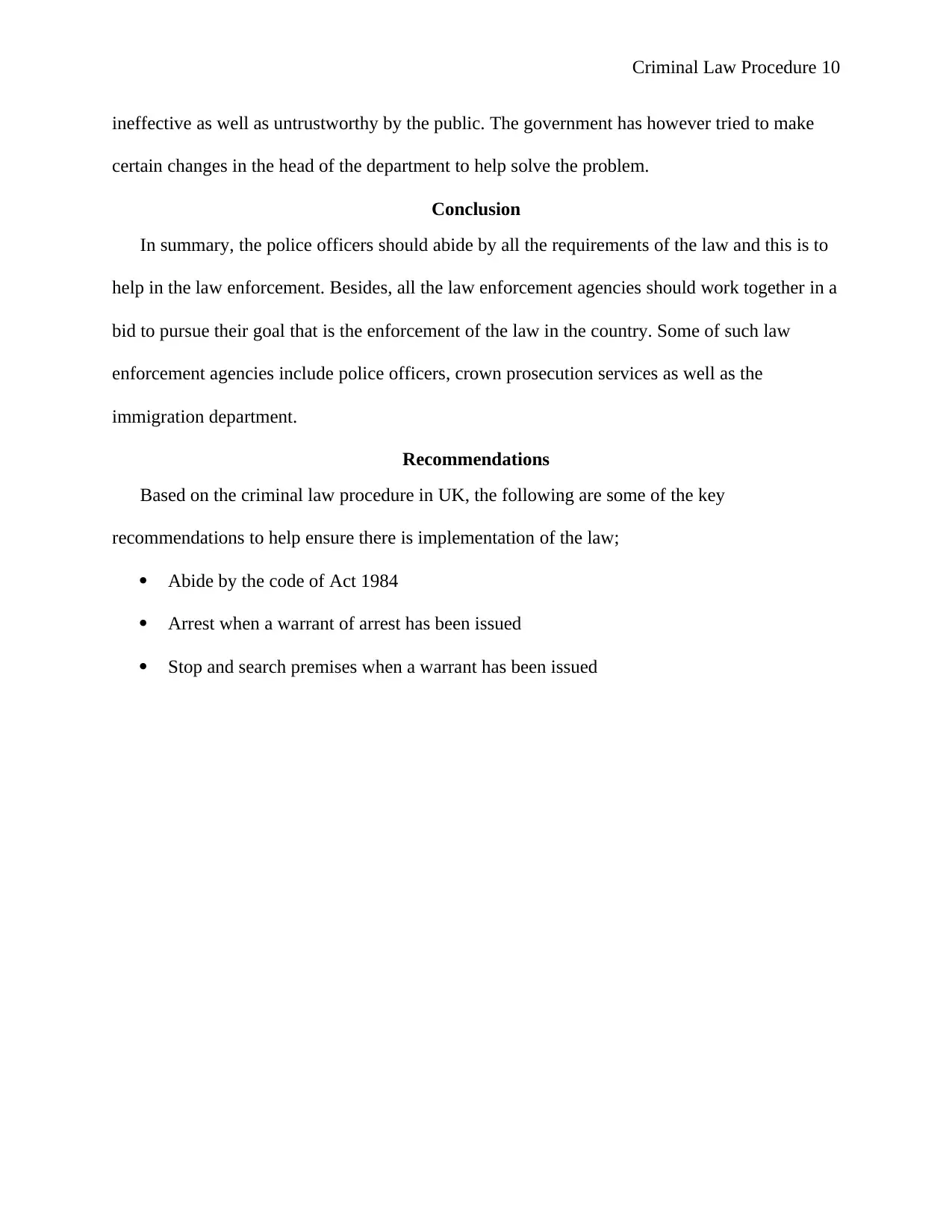
Criminal Law Procedure 10
ineffective as well as untrustworthy by the public. The government has however tried to make
certain changes in the head of the department to help solve the problem.
Conclusion
In summary, the police officers should abide by all the requirements of the law and this is to
help in the law enforcement. Besides, all the law enforcement agencies should work together in a
bid to pursue their goal that is the enforcement of the law in the country. Some of such law
enforcement agencies include police officers, crown prosecution services as well as the
immigration department.
Recommendations
Based on the criminal law procedure in UK, the following are some of the key
recommendations to help ensure there is implementation of the law;
Abide by the code of Act 1984
Arrest when a warrant of arrest has been issued
Stop and search premises when a warrant has been issued
ineffective as well as untrustworthy by the public. The government has however tried to make
certain changes in the head of the department to help solve the problem.
Conclusion
In summary, the police officers should abide by all the requirements of the law and this is to
help in the law enforcement. Besides, all the law enforcement agencies should work together in a
bid to pursue their goal that is the enforcement of the law in the country. Some of such law
enforcement agencies include police officers, crown prosecution services as well as the
immigration department.
Recommendations
Based on the criminal law procedure in UK, the following are some of the key
recommendations to help ensure there is implementation of the law;
Abide by the code of Act 1984
Arrest when a warrant of arrest has been issued
Stop and search premises when a warrant has been issued
Paraphrase This Document
Need a fresh take? Get an instant paraphrase of this document with our AI Paraphraser
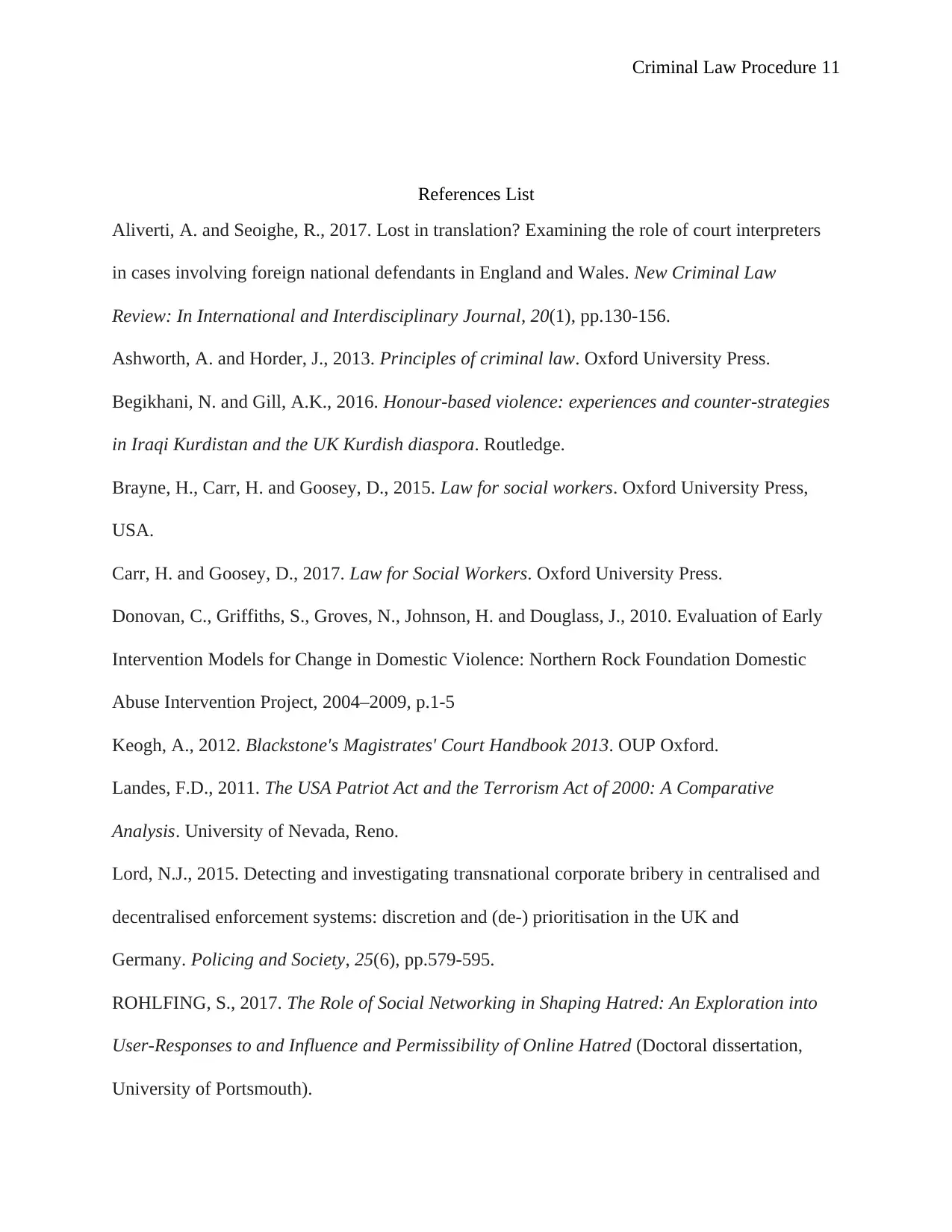
Criminal Law Procedure 11
References List
Aliverti, A. and Seoighe, R., 2017. Lost in translation? Examining the role of court interpreters
in cases involving foreign national defendants in England and Wales. New Criminal Law
Review: In International and Interdisciplinary Journal, 20(1), pp.130-156.
Ashworth, A. and Horder, J., 2013. Principles of criminal law. Oxford University Press.
Begikhani, N. and Gill, A.K., 2016. Honour-based violence: experiences and counter-strategies
in Iraqi Kurdistan and the UK Kurdish diaspora. Routledge.
Brayne, H., Carr, H. and Goosey, D., 2015. Law for social workers. Oxford University Press,
USA.
Carr, H. and Goosey, D., 2017. Law for Social Workers. Oxford University Press.
Donovan, C., Griffiths, S., Groves, N., Johnson, H. and Douglass, J., 2010. Evaluation of Early
Intervention Models for Change in Domestic Violence: Northern Rock Foundation Domestic
Abuse Intervention Project, 2004–2009, p.1-5
Keogh, A., 2012. Blackstone's Magistrates' Court Handbook 2013. OUP Oxford.
Landes, F.D., 2011. The USA Patriot Act and the Terrorism Act of 2000: A Comparative
Analysis. University of Nevada, Reno.
Lord, N.J., 2015. Detecting and investigating transnational corporate bribery in centralised and
decentralised enforcement systems: discretion and (de-) prioritisation in the UK and
Germany. Policing and Society, 25(6), pp.579-595.
ROHLFING, S., 2017. The Role of Social Networking in Shaping Hatred: An Exploration into
User-Responses to and Influence and Permissibility of Online Hatred (Doctoral dissertation,
University of Portsmouth).
References List
Aliverti, A. and Seoighe, R., 2017. Lost in translation? Examining the role of court interpreters
in cases involving foreign national defendants in England and Wales. New Criminal Law
Review: In International and Interdisciplinary Journal, 20(1), pp.130-156.
Ashworth, A. and Horder, J., 2013. Principles of criminal law. Oxford University Press.
Begikhani, N. and Gill, A.K., 2016. Honour-based violence: experiences and counter-strategies
in Iraqi Kurdistan and the UK Kurdish diaspora. Routledge.
Brayne, H., Carr, H. and Goosey, D., 2015. Law for social workers. Oxford University Press,
USA.
Carr, H. and Goosey, D., 2017. Law for Social Workers. Oxford University Press.
Donovan, C., Griffiths, S., Groves, N., Johnson, H. and Douglass, J., 2010. Evaluation of Early
Intervention Models for Change in Domestic Violence: Northern Rock Foundation Domestic
Abuse Intervention Project, 2004–2009, p.1-5
Keogh, A., 2012. Blackstone's Magistrates' Court Handbook 2013. OUP Oxford.
Landes, F.D., 2011. The USA Patriot Act and the Terrorism Act of 2000: A Comparative
Analysis. University of Nevada, Reno.
Lord, N.J., 2015. Detecting and investigating transnational corporate bribery in centralised and
decentralised enforcement systems: discretion and (de-) prioritisation in the UK and
Germany. Policing and Society, 25(6), pp.579-595.
ROHLFING, S., 2017. The Role of Social Networking in Shaping Hatred: An Exploration into
User-Responses to and Influence and Permissibility of Online Hatred (Doctoral dissertation,
University of Portsmouth).

Criminal Law Procedure 12
Wilson, S. and Mitchell, R., 2011. English Legal System Directions. Oxford University Press.
Jess, D.C., 2011. The insurance of commercial risks: law and practice. Sweet & Maxwell.
Ward, R. and Akhtar, A., 2011. Walker & Walker's English legal system. Oxford University
Press.
Wilson, S. and Mitchell, R., 2011. English Legal System Directions. Oxford University Press.
Jess, D.C., 2011. The insurance of commercial risks: law and practice. Sweet & Maxwell.
Ward, R. and Akhtar, A., 2011. Walker & Walker's English legal system. Oxford University
Press.
⊘ This is a preview!⊘
Do you want full access?
Subscribe today to unlock all pages.

Trusted by 1+ million students worldwide
1 out of 12
Related Documents
Your All-in-One AI-Powered Toolkit for Academic Success.
+13062052269
info@desklib.com
Available 24*7 on WhatsApp / Email
![[object Object]](/_next/static/media/star-bottom.7253800d.svg)
Unlock your academic potential
Copyright © 2020–2025 A2Z Services. All Rights Reserved. Developed and managed by ZUCOL.





